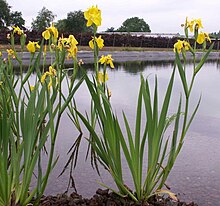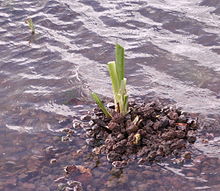A flowering water-purifying plant (Iris pseudacorus)
Role of biota
Biota are an essential component of most sewage treatment processes and many water purification systems. Most of the organisms involved are derived from the waste, wastewater or water stream itself or from the atmosphere or soil water. However some processes, especially those involved in removing very low concentrations of contaminants, may use engineered eco-systems created by the introduction of specific plants and sometimes animals. Some full scale sewage treatment plants also use constructed wetlands to provide treatmen.Pollutants in wastewater
Pathogens
Parasites, bacteria and viruses may be injurious to the health of people or livestock ingesting the polluted water. These pathogens may have originated from sewage or from domestic or wild bird or mammal feces. Pathogens may be killed by ingestion by larger organisms, oxidation, infection by phages or irradiation by ultraviolet sunlight unless that sunlight is blocked by plants or suspended solids.Suspended solids
Particles of soil or organic matter may be suspended in the water. Such materials may give the water a cloudy or turbid appearance. The anoxic decomposition of some organic materials may give rise to obnoxious or unpleasant smells as sulphur containing compounds are released.Nutrients
Compounds containing nitrogen, potassium or phosphorus may encourage growth of aquatic plants and thus increase the available energy in the local food-web. this can lead to increased concentrations of suspended organic material. In some cases specific micro-nutrients may be required to allow the available nutrients to be fully utilised by living organisms. In other cases, the presence of specific chemical species may produce toxic effects limiting growth and abundance of living matter.Metals
Many dissolved or suspended metal salts exert harmful effects in the environment sometimes at very low concentrations. Some aquatic plants are able to remove very low metal concentrations, with the metals ending up bound to clay or other mineral particles.Organisms
Saprophytic bacteria and fungi can convert organic matter into living cell mass, carbon dioxide, water and a range of metabolic by-products. These saprophytic organisms may then be predated upon by protozoa, rotifers and, in cleaner waters, Bryozoa which consume suspended organic particles including viruses and pathogenic bacteria. Clarity of the water may begin to improve as the protozoa are subsequently consumed by rotifers and cladocera. Purifying bacteria, protozoa, and rotifers must either be mixed throughout the water or have the water circulated past them to be effective. Sewage treatment plants mix these organisms as activated sludge or circulate water past organisms living on trickling filters or rotating biological contactors.Aquatic vegetation may provide similar surface habitat for purifying bacteria, protozoa, and rotifers in a pond or marsh setting; although water circulation is often less effective. Plants and algae have the additional advantage of removing nutrients from the water; but some of those nutrients will be returned to the water when the plants die unless the plants are removed from the water. Because of the complex chemistry of Phosphorus much of this element is in an unavailable form unless decomposition creates anoxic conditions which render the phosphorus available for re-uptake. Plants also provide shade, a refuge for fish, and oxygen for aerobic bacteria. In addition, fish can limit pests such as mosquitoes. Fish and waterfowl feces return waste to the water, and their feeding habits may increase turbidity. Cyanobacteria have the disadvantageous ability to add nutrients from the air to the water being purified and to generate toxins in some cases.
The choice of organism depends on the local climate different species and other factors. Indigenous species usually tend to be better adapted to the local environment.
Macrophytes
A water-purifying plant (Iris pseudacorus) in growth after winter (leaves die at that time of year)
The choice of plants in engineered wet-lands or managed lagoons is dependent on the purification requirements of the system and this may involve plantings of varying plant species at a range of depths to achieve the required goal.
Plants purify water by consuming excess nutrients and by providing surfaces upon which a wide range of other purifying organisms can live. They also are effective oxygenators in sunlight. They also have the ability to translocate chemicals between their submerged foliage and their root systems and this is of significance in engineered wet-lands designed to de-toxify waste waters. Plants that have been used in temperate climates include Nymphea alba, Phragmites australis, Sparganium erectum, Iris pseudacorus, Schoenoplectus lacustris and Carex acutiformis.
Where oxygenation is a critical requirement Stratiotes aloides, Hydrocharis morsus-ranae, Acorus calamus, Myriophyllum species and Elodea have been used. Hydrocharis morsus-ranae and Nuphar lutea have been used where shade and cover are require.


